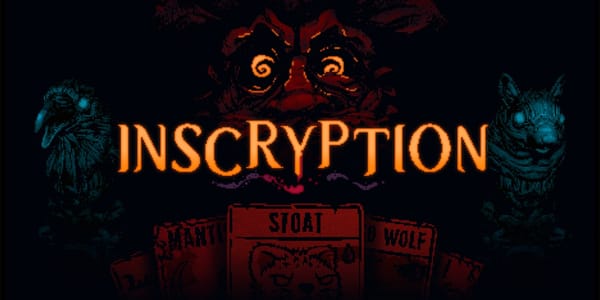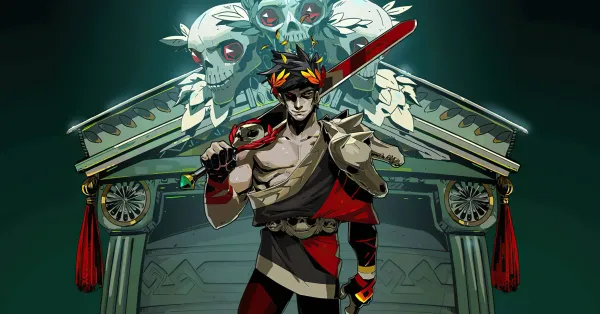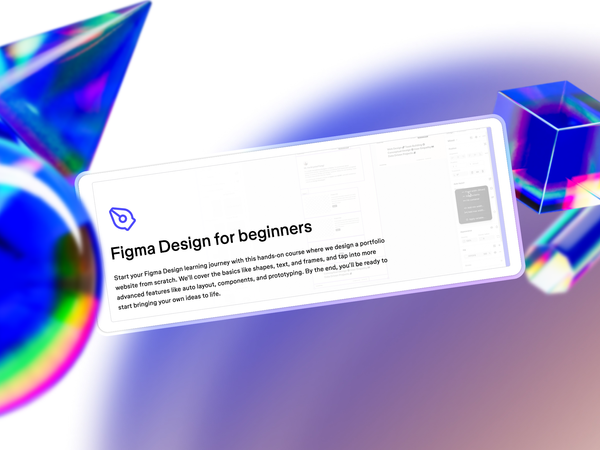I still think that Inscryption’s one of the smartest bits of game design out there.
This genre-defying experience, released in 2021, combines deck-building mechanics with escape room puzzles and psychological horror, creating something that still resonates with players precisely because of how it breaks conventional design rules.
Design Study: Blood, Bones, and Brilliant Risk-Reward Systems
Inscryption's core design brilliance begins with its resource management system.
Unlike traditional card games that rely on mana pools or energy counters, designer Daniel Mullins built the game around sacrifice. Players must offer their own creatures to summon stronger ones, creating an immediate emotional and strategic tension.

This blood resource system accomplishes several design goals simultaneously:
- It creates meaningful decisions from the very first turn
- It attaches value to even the weakest cards (those Squirrels aren't just chaff)
- It forces players to constantly evaluate short-term losses versus long-term gains
The bone collection mechanic, which activates later, adds another brilliant layer. Now player decisions become multi-dimensional: do I sacrifice creatures for immediate blood value, or do I play the long game by accumulating bones for different cards?
This layering of systems creates what game designers call "interesting decisions" - choices with no obvious correct answer that require weighing multiple variables.
The sigil system might be Inscryption's most elegant design element. By attaching special abilities to cards, Mullins created near-endless combinations that encourage experimentation.
When players discover how these sigils can interact in unexpected ways, it delivers those coveted "eureka moments" that keep players engaged and talking with others about their discoveries.
The Meta-Game: Designing for Discovery
Between battles, Inscryption's map exploration system demonstrates another design triumph. Rather than simply presenting a series of card battles, Mullins created a discovery loop that keeps players engaged:
- Encounter an unusual event (the campfire, Mycologists, etc.)
- Make a high-risk, high-reward decision
- See the often surprising consequences
- Integrate this new knowledge into future strategy
This structure creates what psychologists call "operant conditioning" - random reward schedules that keep players coming back.
Sometimes your card emerges stronger from the campfire; sometimes it's devoured. This unpredictability is carefully calibrated to make successful outcomes feel earned rather than granted.

The death card mechanic brilliantly transforms failure into progression. When players lose, they create a custom card that joins their deck for future runs. This ingenious design choice accomplishes two things: it softens the sting of defeat and gives players agency in how they respond to failure.
Few games have integrated loss so seamlessly into their core progression system.
Subverting Expectations: The Design Philosophy of Genre Shifts
Perhaps Inscryption's most controversial design choice is its dramatic mid-game transformation. Just as players master the cabin's card mechanics, the game completely reinvents itself with new aesthetics and rule systems across multiple acts.
This decision represents a fundamental design philosophy: Mullins prioritized narrative impact and surprise over consistent gameplay loops.
This approach challenges conventional game design wisdom, which typically emphasizes mastery curves where players steadily improve at a consistent set of mechanics. Instead, Inscryption deliberately disrupts player comfort to serve its meta-narrative.

It's a design risk that sparked debate within the gaming community - some players felt it undermined the excellent systems established in Act 1, while others praised the audacity of a game willing to reinvent itself multiple times.
From a design perspective, these shifts accomplish something remarkable: they force players to constantly recontextualize what they think they know. Each time players adjust to new rules, they must reconsider their assumptions about both the game's systems and its narrative.
This layered experience creates a deeper level of engagement than a single, consistent system ever could, even if it comes at the cost of mechanical depth in later sections.
What Makes Inscryption's Design Endure
Years after its release, what makes Inscryption's design continue to resonate? The answer lies in how it balances several seemingly contradictory elements:
- Simplicity and depth: The core mechanics are immediately understandable (sacrifice creatures for blood), but the interactions between systems create tremendous complexity.
- Structure and discovery: The game provides clear goals and rules while constantly encouraging experimentation beyond obvious strategies.
- Horror and playfulness: The unsettling atmosphere is balanced with moments of dark humor and the joy of breaking systems through clever card combinations.
- Narrative and mechanics: Unlike many games where story and gameplay feel disconnected, Inscryption's narrative twists directly inform its mechanical shifts.
Inscryption's design brilliance ultimately stems from how it respects player intelligence. It trusts players to adapt to changing systems, to find unintended card combinations, and to piece together its fragmented narrative.
In an industry often afraid of challenging players too much, Inscryption demonstrates that a game can break rules and player expectations while still delivering a profoundly satisfying experience.

That satisfaction comes from the moment when you realize you've created a card so powerful it practically plays itself, or when you finally understand how seemingly disparate narrative elements connect.
These moments of mechanical and intellectual discovery represent gaming at its most distinctive and powerful – and they explain why, years after release, players still gather around digital campfires to discuss the strange, wonderful experience that is Inscryption.
Just be prepared to make a few sacrifices along the way.












